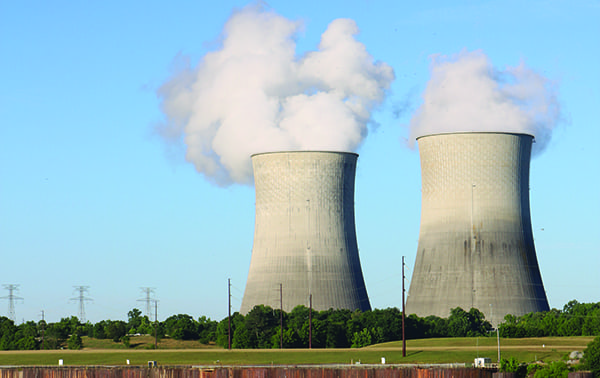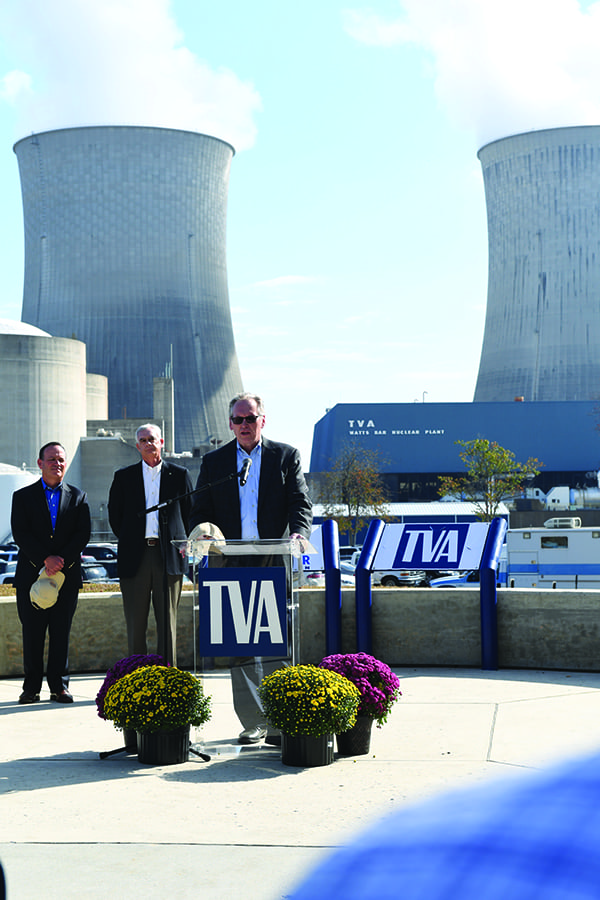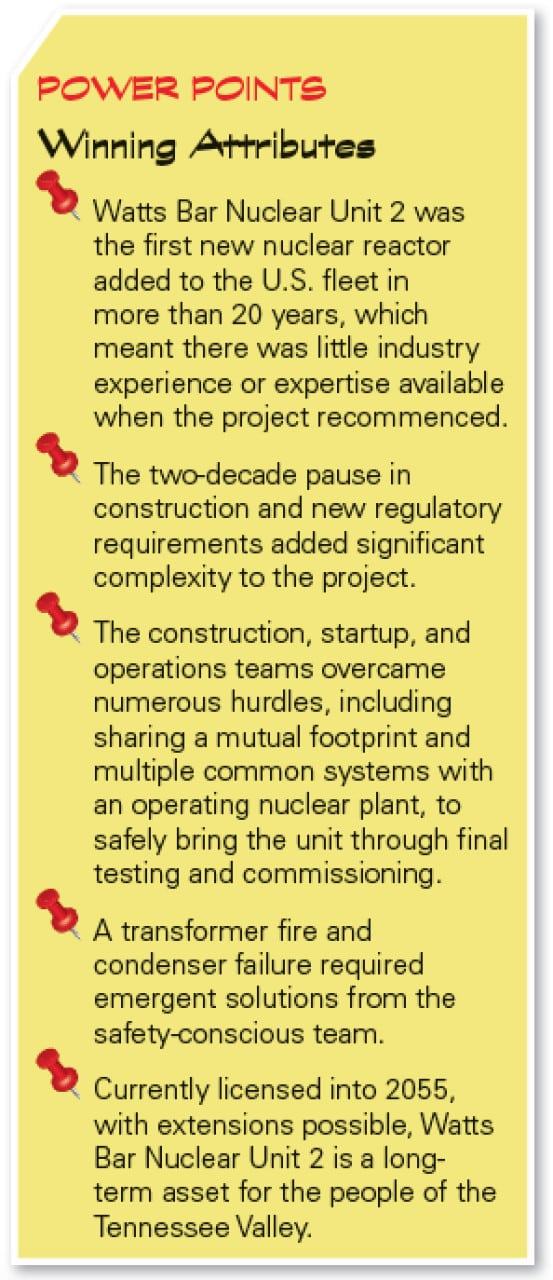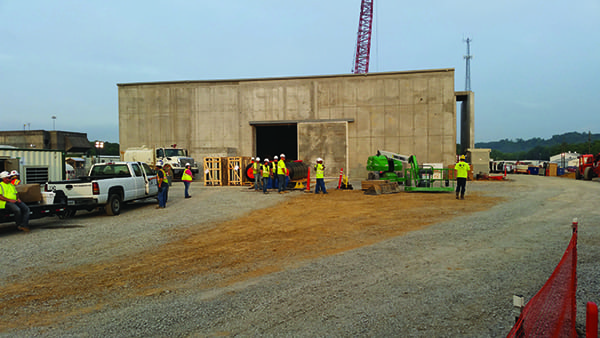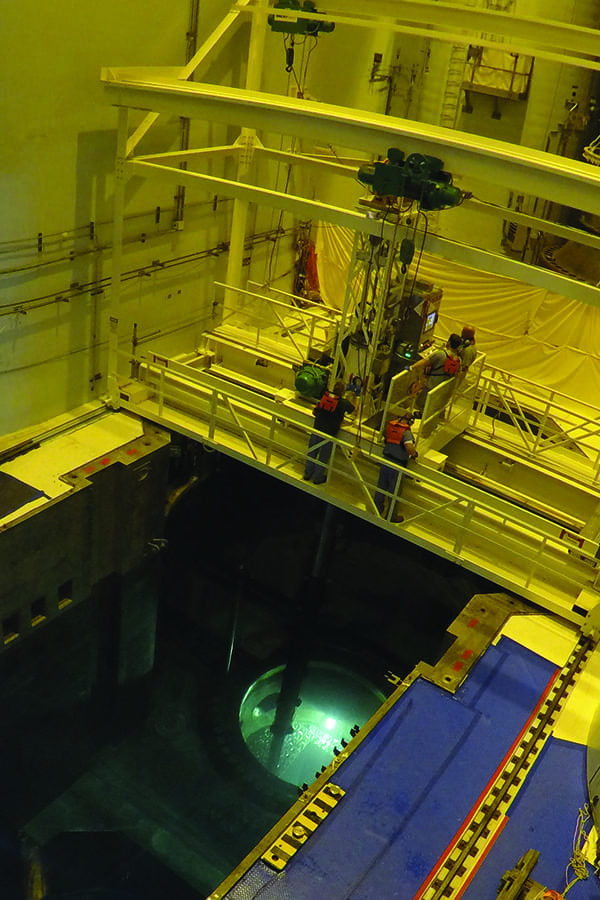Commitment, Teamwork, and Perseverance Pay Off as Nuclear Unit Wins Plant of the Year
The Tennessee Valley Authority’s Watts Bar Nuclear Plant Unit 2 was the first new nuclear unit added to the U.S. fleet in more than 20 years. There were challenges along the way, but the colossal effort displayed by the dedicated construction, startup, and operations teams make it deserving of POWER’s highest honor.
For decades, a single cooling tower released cloud-like condensate around-the-clock while Watts Bar Nuclear Plant Unit 1 (WBN1) was online. Meanwhile, yards away, a second concrete giant sat idle against the scenic backdrop of the Tennessee River, about 10 miles south of Spring City, Tennessee. But that has all changed now. Clouds regularly surge skyward from both of the iconic 504-foot-tall structures, signifying dual-unit operation at the facility.
With the backdrop of the two billowing cooling towers, Tennessee Valley Authority (TVA) executives announced to a large contingent of media and guests in October 2016 that Watts Bar Nuclear Plant Unit 2 (WBN2) had entered commercial operation. “If you’re in our business, this is a beautiful sight,” said TVA President and CEO Bill Johnson, referring to the scene behind him (Figure 1).
“Even during the final days of construction, there were long-time residents of the area who didn’t believe they would ever see both of our cooling towers in operation,” said Watts Bar Site Vice President Paul Simmons. “They doubted Unit 2 would ever be completed and run. But our team knew they would get the job done—safely and with high quality. They were committed to bringing Watts Bar Unit 2 online the right way and transitioning us into a dual-unit site.
“There were lots of challenging days during construction, startup testing, and initial operation, but those were met with determination and perseverance,” Simmons added. “If you want the single largest reason we achieved dual-unit operations, it is the commitment and resilience of the TVA, Watts Bar, and construction teams. Individuals took great pride in the industry-leading milestone of starting the first new U.S. commercial nuclear unit in this century.”
A Challenging Endeavor
The process of building a nuclear power plant takes years of preparation and millions of work-hours to complete. Ground was initially broken on both Watts Bar units in 1973 during the U.S.’s nuclear power heyday. However, a decision was soon made to focus on the lead plant—WBN1—while deferring work on WBN2. Construction was completely suspended on WBN2 in 1985 due to slower electricity demand growth, rising construction costs resulting from inflation and new Nuclear Regulatory Commission (NRC) requirements following the accident at Three Mile Island, and other regulatory concerns throughout TVA’s fleet. WBN1 continued to move forward and entered commercial operation in May 1996.
It was not until 2007 that TVA completed a Detailed Scoping, Estimating, and Planning study for WBN2. With year-over-year load growth averaging about 3% at the time, TVA’s board decided the WBN2 project, which was estimated to be 60% complete, was worth continuing.
“There were advantages to having large amounts of infrastructure in place in a plant that was initially designed to have two units,” said Simmons. “But it also created a unique challenge of building and testing systems adjacent or connected to an operational unit. We had to identify ways to safely complete systems next to energized, pressurized, and heated components. We had to develop plant testing methodology around shared systems like our essential raw cooling water. Our focus always had to include protecting Watts Bar Unit 1.”
In 2008, construction resumed on WBN2 with Bechtel Corp. functioning as the primary construction contractor, which it did through project completion. Some changes were made in subsequent years—a new leadership team was put in place, shortcomings that led to schedule delays were identified and corrected, new processes and management systems were installed to better track progress, and the workforce was reduced to a more manageable size. Productivity increased as a result.
“The biggest improvements were around the areas of project organization,” said Simmons. “We focused on a system-by-system approach and better prioritized work to meet clear milestone objectives. This helped leadership get a more accurate picture of progress, dig deeper into details of specific construction issues, and proactively identify and mitigate potential challenges before they resulted in delays.”
Two Major Tasks
During WBN2 construction, two major tasks emerged. First, validating that existing infrastructure met current regulatory and technical requirements. Second, completing the construction and testing of new systems in an orderly fashion that kept the project moving ahead.
“We developed a refurbishment plan that was approved by the NRC to validate existing infrastructure met today’s standards,” said Simmons. “You cannot take anything for granted at a nuclear plant. It all had to be tested for integrity or performance to meet the level of safety and quality Watts Bar and TVA were committed to upholding.”
For example, core bore sampling was necessary on previously installed concrete. The samples taken had to be broken to verify that the strength satisfied, or exceeded, the original design specification. Steel embedded in the concrete also required evaluation.
Voltage testing had to be conducted on cabling to verify that the conductors and the insulation hadn’t degraded or broken down over the years. Miles of new cabling were installed to either replace, upgrade, or augment existing wiring. Similarly, a large amount of original piping was replaced, much of it due to design revisions calling for different sizes or grades of material. Borescope inspections were conducted to verify the internal condition of some piping and detailed flushing procedures were carried out to ensure pipe cleanliness met requirements.
Large pumps and motors were removed and shipped to manufacturers for refurbishment to ensure they adhered to design and performance requirements. In some cases, new equipment was procured to ensure long-term plant reliability.
In few places were upgrades more extensive than in the WBN2 main control room. Instruments and controls were made to match the WBN1 control room setup so that nuclear operators could be licensed for both Watts Bar units. Unit 2 switches were refurbished, tested, and reinstalled, supported by more than 80,000 feet of new wiring. As new technology was installed, including digital control upgrades, similar enhancements were made to Unit 1 during refueling outages.
“We set three priorities during Unit 2 construction,” said Simmons. “Safety was our overriding priority in everything we did. During construction, we worked approximately 34 million consecutive man-hours with no lost-time injuries. A close second was quality as we refurbished or replaced materials. Everyone understood equipment and components in Unit 2 had to run reliably for decades into the future. And third was protecting the operating unit as we installed and tested various equipment.”
WBN2 came to life through a systematic construction and testing process. The construction group was in charge of building 88 separate systems within the plant. Once a system was deemed “construction-complete,” it was turned over to the startup group. Startup personnel verified component/system quality, with more than 8,900 individual components tested. When startup criteria were satisfied, walkdowns were held by the plant operations group to validate that systems were fully ready to run reliably.
“As we moved from system startup to pre-operational testing to overall plant startup, our TVA Nuclear Engineering team stepped up to provide vital technical expertise and help us resolve challenges,” said TVA Executive Vice President of Operations Mike Skaggs, who was senior vice president for Watts Bar Operations and Construction during the WBN2 project. “David Czufin, senior vice president, Engineering and Operations Support, and the engineering team were a key group in ensuring equipment and systems were ready for more robust testing and operational conditions at each stage of plant startup.”
Pre-Licensing Testing
In the later phases of construction, a multitude of pre-operational tests were performed, followed by equipment functionality checks. TVA had to go through a very deliberate process to validate that all of the equipment required prior to fuel load was operable and met license requirements. This included open reactor vessel testing, primary and secondary hydrostatic testing, hot functional testing, containment integrated leak rate testing, and integrated testing of safety systems.
“At each stage of plant testing, we had more and more systems working together under greater temperatures and pressures,” said Simmons. “But rather than drive on toward the next milestone, we took the time to properly resolve any issues testing revealed. While it might have had a short-term impact to the schedule, taking that time on the front end meant we were in better shape heading into the next test. The end result was that our team and the plant were set up for success at each milestone, which allowed us to move through the entire sequence more efficiently and effectively.”
Before WBN2 received its operating license from the NRC, the Watts Bar plant had to comply with Fukushima mitigation strategies. The plant had to do many things to make that happen, including adding a “FLEX” building (Figure 2), additional diesel generators, a new 500,000-gallon water tank, and portable and pre-staged FLEX equipment. Watts Bar was the first nuclear facility in the U.S. to report compliance.
Substantial Completion to Commercial Operation
On August 19, 2015, TVA declared WBN2 substantially complete—a construction contract term that indicates the progress of work is sufficiently complete in accordance with the contract so the owner can occupy or utilize the plant for its intended use. The NRC issued WBN2’s operating license on October 22, 2015. TVA then had to go through a very deliberate process to validate that all of the equipment required to load fuel was operable and met license requirements. On December 5, 2015, workers began loading the 193 fuel assemblies into the reactor (Figure 3), which took roughly 10 days.
Many more assessments were required, including physics testing and full temperature and pressure testing. On May 23, 2016, WBN2 achieved initial criticality at 2:16 a.m. What that meant was the reactor’s neutron population had remained steady from one generation to the next and the nuclear fission chain reaction was self-sustaining for the first time. Operators then conducted a series of power ascension tests, and on June 3, 2016, the generator was synchronized to the power grid for the first time (Figure 4).
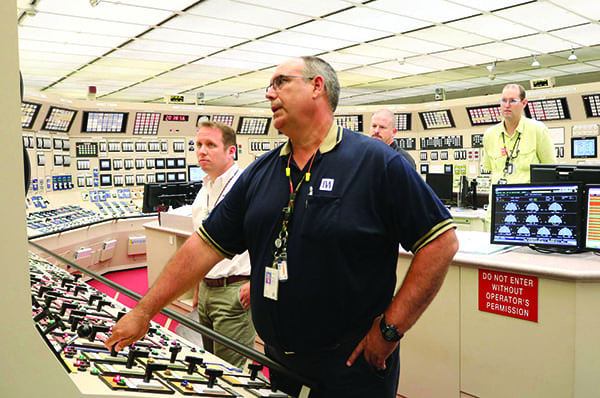 |
| 4. Initial synchronization. Reactor Operator Bill Hahn is shown here synchronizing Watts Bar Nuclear Unit 2 to the TVA power grid for the first time on June 3, 2016. Source: TVA |
On August 30, 2016, as the reactor was being brought up to full power for the first time, an electrical fault on the 2B main bank transformer caused WBN2’s main turbine and reactor to trip. The main bank transformers are filled with oil, and in this particular instance, the electrical fault resulted in an oil fire. TVA’s onsite emergency response team reacted appropriately to put out the fire; nevertheless, power ascension testing could not resume until a rigorous and detailed inspection, repair, and testing process was performed. The transformer was replaced and returned to service on September 26, 2016.
Power ascension testing included more than 40 required tests at various power levels up to 100% output, with pauses at 30%, 50%, and 75%. The gradual increase in power provided data, which was used to verify that the unit was operating as designed. The testing also included intentional trips of both the reactor and the turbine generator. The deliberate excursions were designed to demonstrate that safety systems worked as intended and would respond adequately during an emergency.
The last hurdle for WBN2 was a pre-commercial reliability run. The unit had to operate at 100% power for a minimum of 20 days before commercial operation could be declared, which it did on October 19, 2016.
However, there have been some hiccups since the unit entered commercial operation. WBN2’s main condenser B waterbox experienced a structural failure in March 2017, but all safety systems functioned as expected and operators responded appropriately to the situation. The unit was shut down as part of a planned evolution, and just as the Watts Bar team had overcome previous challenges, the group got to work and solved the condenser issue.
Solid Operation
In March 2018, POWER had the opportunity to interview TVA CEO Bill Johnson, TVA Executive Vice President of Generation Joe Grimes, and Mike Skaggs. All three spoke highly of the Watts Bar staff and the facility’s performance.
Touching on some of the difficulties WBN2 had experienced, Johnson said, “Whenever you put a new plant of that size online, you’re going to have some shakeout problems, and particularly in a nuclear plant that has millions of parts. And we had some shakeout problems. We had a condenser failure, which is an unusual event, but once we got past that last summer, Watts Bar Nuclear Unit 2 has really run well.”
Skaggs praised the construction, startup, and operations crews. “I would say the team that was assembled—contractors, TVA employees, for example—was a strong team and they did a very nice job. And in hindsight, the plant has run well,” said Skaggs.
Grimes also seemed pleased with how the project turned out. “A number of years ago both our board and the management at the time smartly decided to finish Watts Bar 2. I think Mike Skaggs did an outstanding job leading and running that project and putting it in a position that we could integrate it right into our operating fleet,” he said.
“I believe that TVA’s got a very good plant in Watts Bar 2 that’s going to be safe and reliable and very cost-effective for many years to come,” Skaggs concluded.
TVA can take pride in completing a high-quality project and making believers of local residents, who now consistently see plumes of condensate rising from its twin cooling towers. It may not have been easy, but in the immortal words of Theodore Roosevelt: “Nothing in this world is worth having or worth doing unless it means effort, pain, difficulty.” TVA—a corporate agency of the U.S. government established by another Roosevelt, Franklin D.—deserves credit for its commitment, teamwork, and perseverance. As such, POWER is pleased to recognize WBN2 as its 2018 Plant of the Year. ■
—Aaron Larson is POWER’s executive editor and Bill Sitton is advisor to the Watts Bar Nuclear Plant site vice president with TVA.
